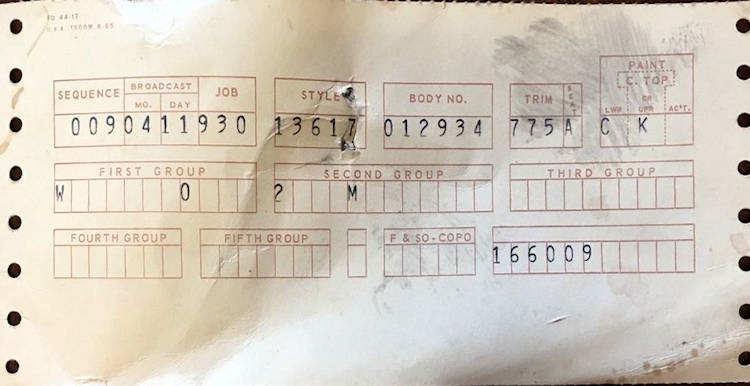Build Sheet Myths/Facts
First off, the term "build sheet" or "buildsheet" (choose your spelling preference) refers to the paperwork the assembly plant would produce to show the various substations of the plant what parts were to be used to build a particular car. This paperwork varies throughout the 1964-1972 model production years and different plants used different forms of paperwork. This paperwork was "broadcast" (sent to) the various substations so they could quickly pull the correct parts for their part of the assembly. The term "build sheet" is applicable to several types of this paperwork such as the BODY and CHASSIS BROADCAST COPY sheets typically used in non-General Motors Assembly Division (GMAD) plants before 1970.
In the case of the BODY and CHASSIS BROADCAST COPY sheets, The Fisher Body side of the assembly plant would get the BODY BROADCAST COPY sheet (example here) and the final assembly side of the assembly plant would get the CHASSIS BROADCAST COPY (example here). The BODY BROADCAST COPY sheet was often attached to the driver side firewall area when mated with the chassis and front sheet metal and have been found by owners when they remove the fenders. Often dealers would request a clean copy of the paperwork be sent with the car and the dealers would keep those on file.
From 1964 through 1967 the trim shop may use their own trim sheet
to direct them with the interior trim selection. The trim sheet
would have an internal sequence number, the date the information was
"broadcast" to them, an internal job number, the car's color and
body number along with various codes to depict options that would
require changes from a base car.

This was often attached to the seat and sent on its way to its
assembly point and are often found in 1964-1967 model year
Chevelles.
The "build sheet" terminology is frequently used to describe the variations of broadcast copy sheets. Prior to the 1969 model year only the Fremont, CA. assembly plant used this form of paperwork. This example is a 1967 Custom El Camino broadcast copy sheet from the Fremont, CA. assembly plant. In 1969 the Fisher Body/Chevrolet separation was merged into one organization, the General Motors Assembly Division and plants began to "standardize" on their broadcast assembly paperwork. Although the overall format of the infamous "build sheet" changed over the ensuing years and data were depicted with plant-specific verbiage and use of various blank (unlabeled) boxes, the "build sheet" has become the holy grail of documentation for SS optioned Chevelles.
Second, this paperwork was not 'hidden' in your car for you to discover 10, 20, 30, or more years later like a treasure hunt. Once a workstation was done with their particular operation on the car the paperwork was useless to them. Various assembly substations would get their own copies of the "build sheet" and may or may not have attached their copy to the assembly they worked on; maybe to identify the car the assembly was going to be installed on and/or maybe just to get rid of the paperwork from their work area. Employees at the various assembly plants did not get together and decide to hide this paperwork so you could find it many years later and there was no standard operating procedure to attach the paperwork to any specific area of the car. There are some more common locations the paperwork have been found; the trim shop at Atlanta in 1970 tended to glue a copy of the paperwork to the inside passenger door card, Arlington would often leave a copy under the driver side footwell, Van Nuys is known for leaving a copy on top of the gas tank. See here for examples for these locations.
If any paperwork was visible during the car's final inspection it would be pulled and trashed along with anything else that a worker may have left in the car like tools, soft drink cans, candy wrappers, etc. Dealers would often request a copy of the paperwork be shipped with each car they ordered from a factory and many dealer's old files still have this paperwork and is found (along with order forms, contracts of the sale, car shippers, dealer invoices, etc.)
Often a build sheet (and sometimes multiple build sheets) are found in Chevelles that do not belong to that particular car. One Kansas City-built Chevelle owner found three build sheets in his car and all three were sequential builds but not one of those three were his car. Another Chevelle owner of a Kansas City-built Chevelle found his build sheet along with the build sheet of a Buick Skylark in this car. Cases like these would indicate that often a workstation would simply toss any paperwork they had left into a Chevelle just to get rid of it from their workstation.

 Home
Home Decode
Decode Tech
Tech Tools
Tools Dale's Coins/CDs
Dale's Coins/CDs Contact
Contact Chevelle
of the Month
Chevelle
of the Month Things
For Sale
Things
For Sale Custom
Stickers
Custom
Stickers